Snake plants (Sansevieria trifasciata), also affectionately called Mother-in-Law’s Tongue, are among the most popular houseplants in the world. Valued for their striking, upright leaves and ability to thrive in neglect, these hardy plants can live for years in various indoor and outdoor settings. They’re also excellent air purifiers, removing toxins like formaldehyde and benzene from indoor air.
While snake plants are incredibly resilient, one thing even seasoned plant parents get wrong is watering. Overwatering is the most common reason snake plants become unhealthy or die. Mastering a proper watering routine is essential for maintaining lush, upright, and healthy foliage — and avoiding the dreaded root rot.
This ultimate guide covers everything you need to know about how, when, and how much to water your snake plant, along with troubleshooting tips and best practices for every season.
Why Watering Matters So Much for Snake Plants
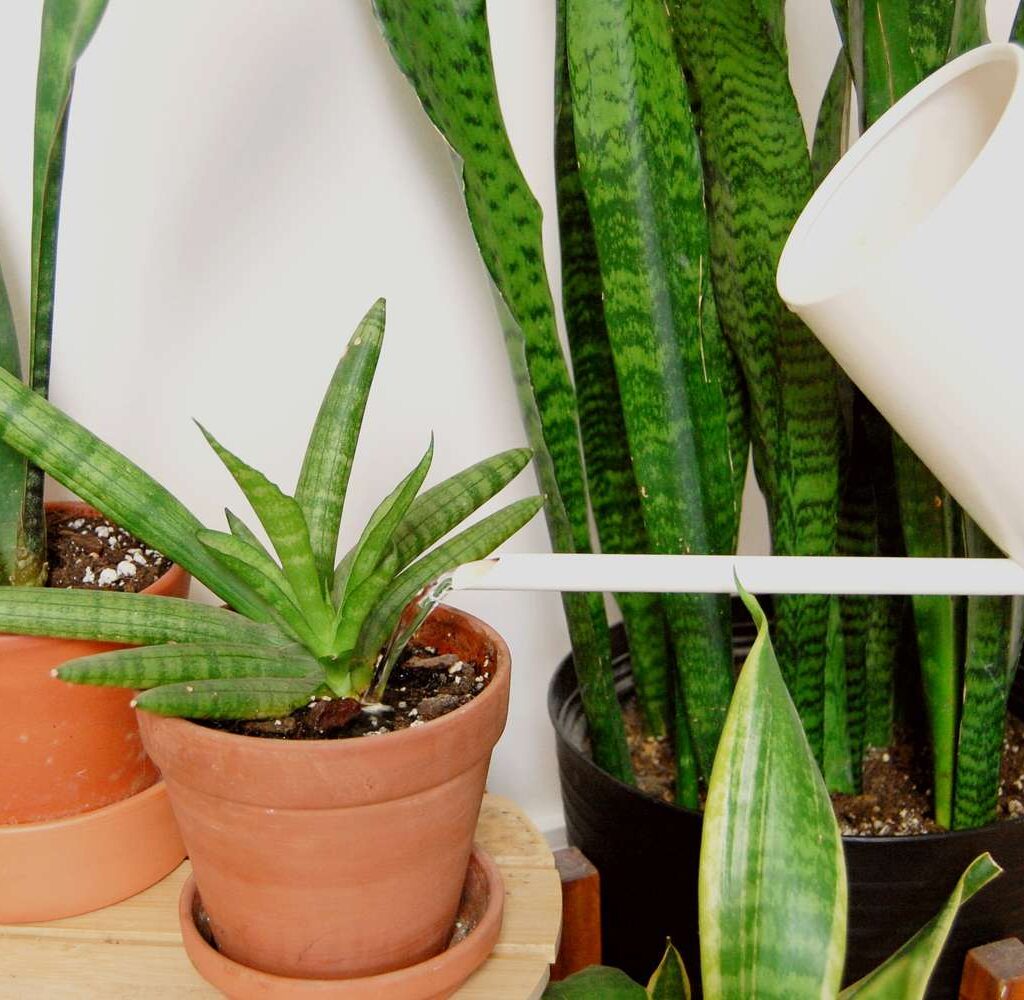
Unlike tropical houseplants, snake plants are succulents native to West Africa. They naturally grow in arid, rocky environments and store water in their thick, fleshy leaves to survive drought. As a result, their water needs are much lower than most indoor plants.
The problem? Many indoor gardeners tend to treat snake plants like their leafy, water-loving counterparts — leading to overwatering, soggy soil, and root rot. On the flip side, underwatering too much can slow growth and cause leaf shriveling.
A balanced, thoughtful watering approach is essential for:
- Supporting maximum growth
- Preserving firm, upright leaves
- Preventing disease and rot
- Ensuring long-term plant health
How Often Should You Water a Snake Plant?
The perfect watering schedule depends on several factors:
- Season
- Light exposure
- Room temperature
- Humidity
- Soil type
- Pot material and size
General Watering Frequency
| Season | Frequency |
|---|---|
| Spring/Summer | Every 10–14 days |
| Fall/Winter | Every 3–5 weeks |
Golden Rule:
Always check soil dryness before watering — never water on a strict calendar.
How to Check if Your Snake Plant Needs Water
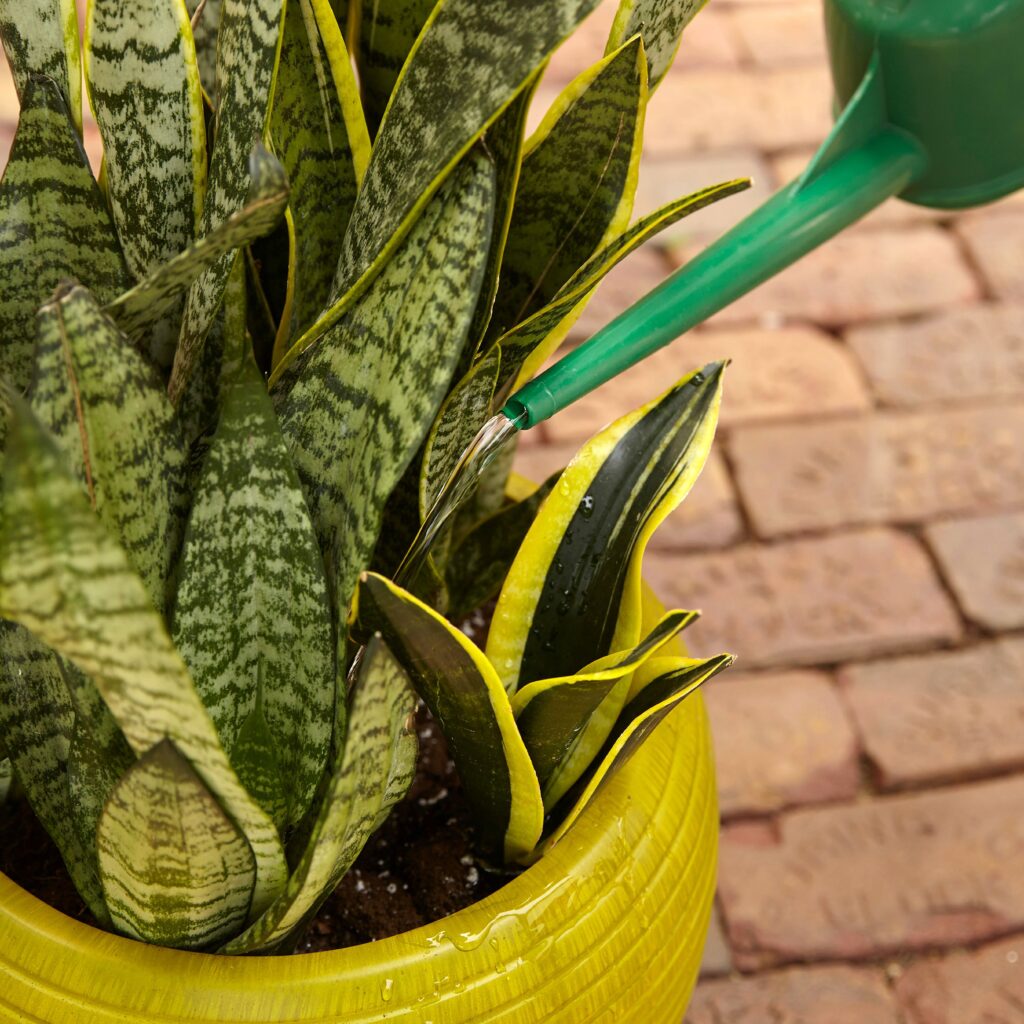
Snake plants hate soggy soil, so it’s vital to ensure the top inches of soil are dry before adding more water.
Methods:
- Finger Test: Stick your finger 1–2 inches deep into the soil. If it’s dry at that depth, it’s safe to water.
- Soil Moisture Meter: A reliable, affordable tool that reads moisture levels at root depth.
- Lift the Pot: For smaller pots, lift it to check the weight — dry soil feels much lighter than wet soil.
If unsure, it’s better to wait a few more days than to risk overwatering.
How to Water Snake Plants the Right Way
The way you water is just as important as how often. Here’s a step-by-step watering routine:
Top Watering (Preferred Method)
- Use room-temperature filtered water.
- Slowly pour water around the inner edges of the pot.
- Continue until water drains from the bottom.
- Empty the saucer after 10–15 minutes.
- Let soil dry completely before the next watering.
Bottom Watering (Optional)
- Place the pot in a tray of water about 2 inches deep.
- Leave it for 15–20 minutes, allowing roots to soak up moisture.
- Remove and let excess water drain out.
Note: Avoid frequent bottom watering to prevent consistently damp soil.
The Best Type of Water for Snake Plants
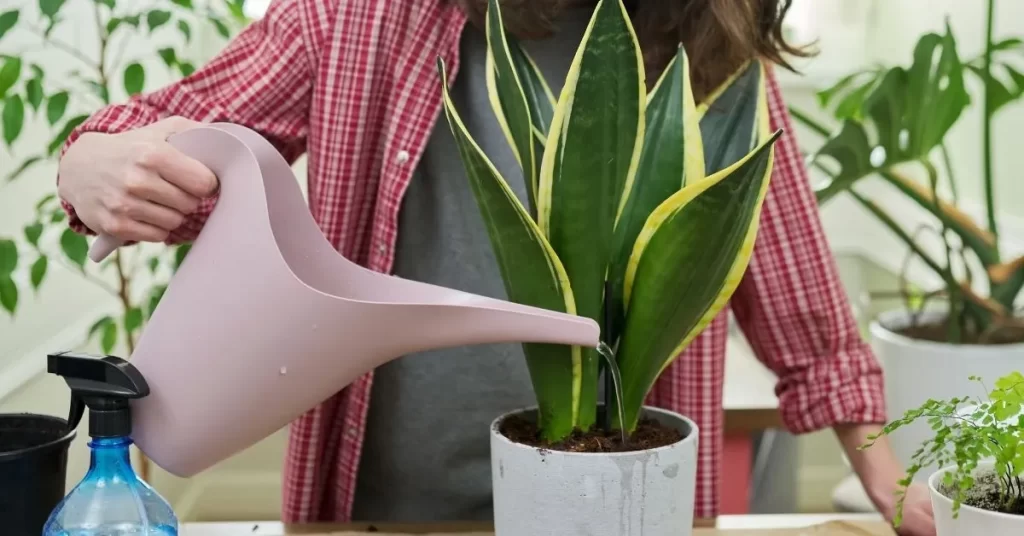
Snake plants are relatively unfussy but prefer:
- Filtered water
- Rainwater
- Distilled water
Avoid using softened or chlorinated tap water regularly, as high salt and mineral content can accumulate in the soil and harm the plant over time.
Choosing the Right Soil and Pot for Watering Success
Watering frequency directly depends on the soil’s ability to drain and the type of pot you use.
Ideal Soil Mix:
- 60% cactus/succulent soil
- 30% perlite or coarse sand
- 10% compost
This well-aerated mix ensures water drains quickly while providing enough nutrients for healthy growth.
Best Pot Types:
- Terracotta pots: Highly breathable, promoting faster soil drying.
- Pots with drainage holes: Always essential to prevent standing water.
Avoid decorative pots without drainage, as these are the leading cause of root rot.
Seasonal Watering Adjustments
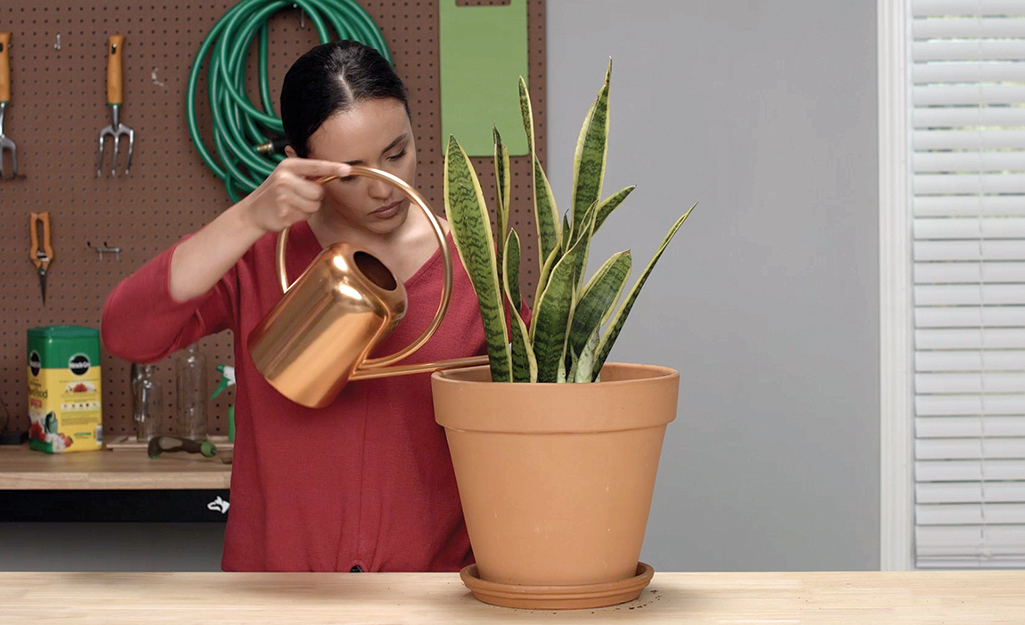
Snake plants’ water needs fluctuate throughout the year:
Spring & Summer:
- Growth is active.
- Water every 10–14 days as soil dries faster.
- Check soil frequently in hot or bright conditions.
Fall & Winter:
- Growth slows.
- Water sparingly — about every 3–5 weeks.
- Ensure soil is completely dry between waterings.
Pro tip: Place plants away from cold drafts and heating vents in winter.
Common Watering Mistakes to Avoid
- Overwatering on a fixed schedule.
- Leaving water in saucers.
- Using soil that’s too dense or heavy.
- Not adjusting for seasonal or room conditions.
Signs of Overwatering and Root Rot
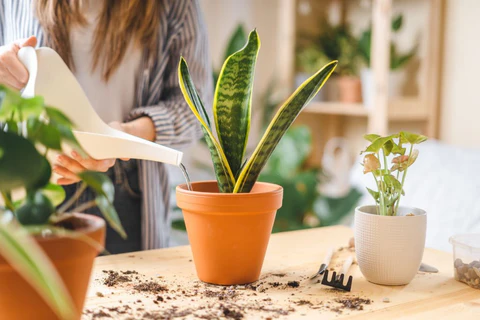
Recognizing early warning signs can save your plant:
Overwatering Symptoms:
- Yellowing leaves
- Soft, mushy foliage
- Brown or black spots on leaves
- Soggy, foul-smelling soil
- Wilting, despite wet soil
Root Rot Indicators:
- Mushy, brown, or blackened roots
- Foul odor from the soil
- Collapsing plant from the base
Immediate Fix:
Remove the plant from its pot, trim rotten roots, and repot in dry, fresh succulent soil.
Tips for Watering in Different Environments
Low Light or Humid Rooms:
- Water less frequently (every 4–5 weeks).
- Soil dries slowly in shaded, humid spaces.
Bright, Sunny Locations:
- Water every 10–14 days in summer.
- Ensure soil doesn’t dry out too quickly.
Outdoor Snake Plants:
- Only water during extended dry spells.
- Avoid exposing to heavy rains or soggy soil.
How to Water Propagated Snake Plants
New cuttings are especially vulnerable to rot.
Watering Tips:
- Allow cut ends to callous for 1–2 days before planting.
- Use a well-draining mix.
- Water lightly once every 2–3 weeks until roots develop.
- Avoid overwatering during early propagation stages.
Final Thoughts: Find the Balance
Snake plants are hardy, but their one vulnerability is overwatering. By following a thoughtful, seasonally adjusted watering schedule and using well-draining soil with a breathable pot, you can keep your plant healthy and beautiful for years to come.
Recap:
- Water every 10–14 days in summer, every 3–5 weeks in winter.
- Always check soil moisture before watering.
- Use a cactus/succulent soil mix in a pot with drainage holes.
- Never leave water in saucers.
- Adjust watering for light, temperature, and humidity changes.
- Recognize early signs of overwatering to prevent root rot.
Master this routine, and you’ll enjoy a thriving, air-purifying snake plant that’s virtually maintenance-free.






Leave A Comment